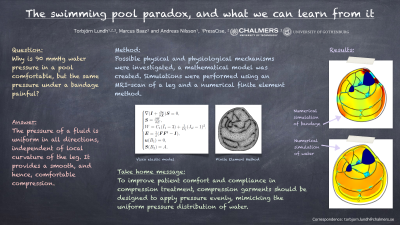Clinical Research
(CR-033) The swimming pool paradox and what we can learn from it
Friday, April 28, 2023
7:15 PM - 8:30 PM East Coast USA Time

Marcus Baaz, MSc; Andreas Nilsson, PhD – CEO, PressCise
Introduction: Standing in a swimming pool with water up to the neck is not an unpleasant experience, quite often the
opposite, even though the pressure from the water at the ankle is about 90 mmHg. This has been
presented as a paradox since applying a pressure, to the same magnitude, with a bandage, is often a unpleasant or even painful experience. What is going on here, and what can we learn from it?
Methods: Possible physical and physiological mechanisms were investigated, a mathematical model was created.
Simulations were performed using an MRI-scan of a leg and a numerical finite element method.
Results: The resulting images from the simulations showed large circumferential pressure variations when the
pressure was applied by a bandage. As expected, this was not the case for water.
Discussion: In a given point in a fluid, like water, the pressure is uniform in all directions, hence the pressure on the ankle is constant regardless of local skin curvature. According to Laplace’s law, a bandage applied with constant tension and overlap, will give a pressure proportional to the local curvature. Hence, a constant pressure would then be applied on a perfectly cylindrical leg (that does not exist). In the swimming pool there is a longitudinal pressure gradient that is perfectly smooth, and over a small distance the change in pressure is modest. This may explain why the gradient exerted by water feels comfortable. This smooth transition together with the absolute even circumferential pressure may be the explanation of the swimming pool paradox. New compression garments should be developed to mimic the evenness of water. This would improve the comfort of the garments and hence improve patient compliance in compression treatment.
opposite, even though the pressure from the water at the ankle is about 90 mmHg. This has been
presented as a paradox since applying a pressure, to the same magnitude, with a bandage, is often a unpleasant or even painful experience. What is going on here, and what can we learn from it?
Methods: Possible physical and physiological mechanisms were investigated, a mathematical model was created.
Simulations were performed using an MRI-scan of a leg and a numerical finite element method.
Results: The resulting images from the simulations showed large circumferential pressure variations when the
pressure was applied by a bandage. As expected, this was not the case for water.
Discussion: In a given point in a fluid, like water, the pressure is uniform in all directions, hence the pressure on the ankle is constant regardless of local skin curvature. According to Laplace’s law, a bandage applied with constant tension and overlap, will give a pressure proportional to the local curvature. Hence, a constant pressure would then be applied on a perfectly cylindrical leg (that does not exist). In the swimming pool there is a longitudinal pressure gradient that is perfectly smooth, and over a small distance the change in pressure is modest. This may explain why the gradient exerted by water feels comfortable. This smooth transition together with the absolute even circumferential pressure may be the explanation of the swimming pool paradox. New compression garments should be developed to mimic the evenness of water. This would improve the comfort of the garments and hence improve patient compliance in compression treatment.

.png)